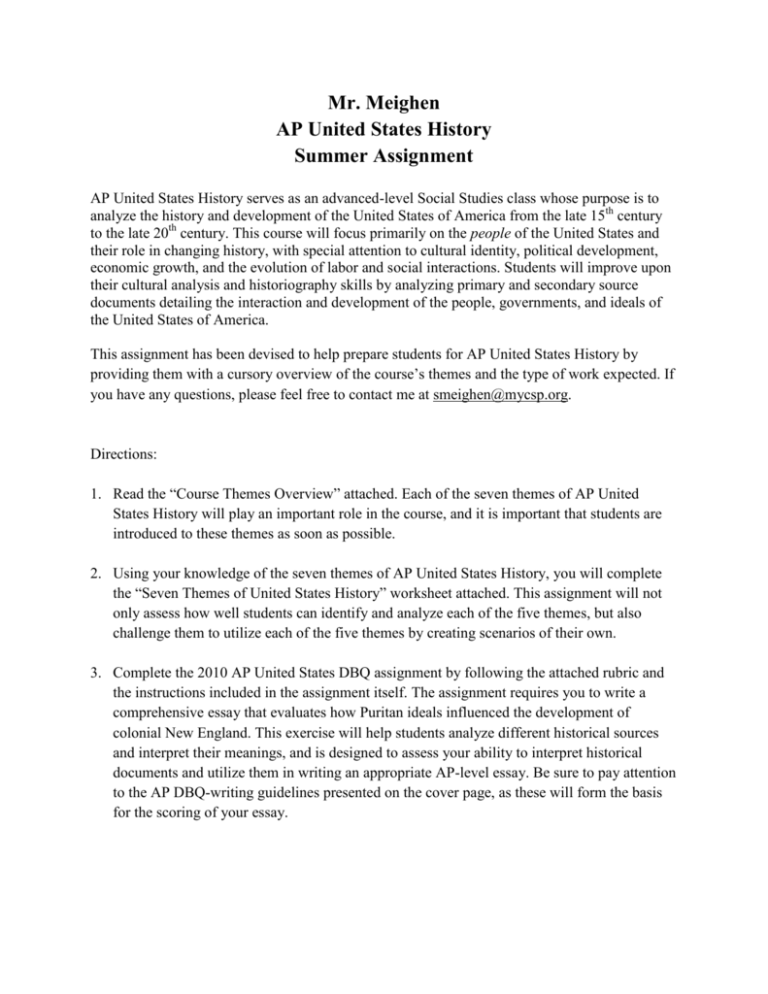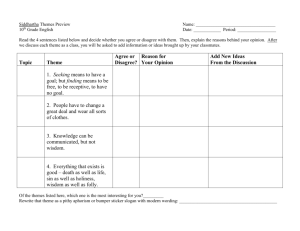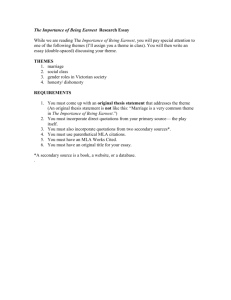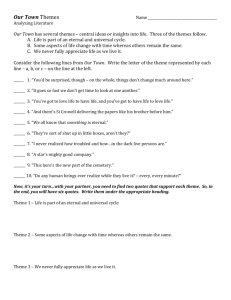Mr. Meighen AP United States History Summer Assignment
advertisement

Mr. Meighen AP United States History Summer Assignment AP United States History serves as an advanced-level Social Studies class whose purpose is to analyze the history and development of the United States of America from the late 15th century to the late 20th century. This course will focus primarily on the people of the United States and their role in changing history, with special attention to cultural identity, political development, economic growth, and the evolution of labor and social interactions. Students will improve upon their cultural analysis and historiography skills by analyzing primary and secondary source documents detailing the interaction and development of the people, governments, and ideals of the United States of America. This assignment has been devised to help prepare students for AP United States History by providing them with a cursory overview of the course’s themes and the type of work expected. If you have any questions, please feel free to contact me at smeighen@mycsp.org. Directions: 1. Read the “Course Themes Overview” attached. Each of the seven themes of AP United States History will play an important role in the course, and it is important that students are introduced to these themes as soon as possible. 2. Using your knowledge of the seven themes of AP United States History, you will complete the “Seven Themes of United States History” worksheet attached. This assignment will not only assess how well students can identify and analyze each of the five themes, but also challenge them to utilize each of the five themes by creating scenarios of their own. 3. Complete the 2010 AP United States DBQ assignment by following the attached rubric and the instructions included in the assignment itself. The assignment requires you to write a comprehensive essay that evaluates how Puritan ideals influenced the development of colonial New England. This exercise will help students analyze different historical sources and interpret their meanings, and is designed to assess your ability to interpret historical documents and utilize them in writing an appropriate AP-level essay. Be sure to pay attention to the AP DBQ-writing guidelines presented on the cover page, as these will form the basis for the scoring of your essay. AP United States History Course Themes Overview Theme 1: Identity Theme 2: Work, Exchange, and Technology Theme 3: Peopling Theme 4: Politics and Power Theme 5: America in the World Theme 6: Environment and Geography Theme 7: Ideas, Beliefs, and Culture The content learning objectives for the AP U.S. History course and exam are organized under seven themes, which are topics of historical inquiry to explore throughout the AP U.S. History course. These themes focus student understanding of major historical issues and developments, helping students to recognize broad trends and processes that have emerged over centuries in what has become the United States. Theme 1: Identity This theme focuses on the formation of both American national identity and group identities in U.S. history. Students should be able to explain how various identities, cultures, and values have been preserved or changed in different contexts of U.S. history, with special attention given to the formation of gender, class, racial, and ethnic identities. Students should be able to explain how these sub-identities have interacted with each other and with larger conceptions of American national identity. Theme 2: Work, Exchange, and Technology This theme focuses on the development of American economies based on agriculture, commerce, and manufacturing. Students should examine ways that different economic and labor systems, technological innovations, and government policies have shaped American society. Students should explore the lives of working people and the relationships among social classes, racial and ethnic groups, and men and women, including the availability of land and labor, national and international economic developments, and the role of government support and regulation. Theme 3: Peopling This theme focuses on why and how the various people who moved to, from, and within the United States adapted to their new social and physical environments. Students examine migration across borders and long distances, including the slave trade and internal migration, and how both newcomers and indigenous inhabitants transformed North America. The theme also illustrates how people responded when “borders crossed them.” Students explore the ideas, beliefs, traditions, technologies, religions, and gender roles that migrants/immigrants and annexed peoples brought with them and the impact these factors had on both these peoples and on U.S. society. Theme 4: Politics and Power Students should examine ongoing debates over the role of the state in society and its potential as an active agent for change. This includes mechanisms for creating, implementing, or limiting participation in the political process and the resulting social effects, as well as the changing relationships among the branches of the federal government and among national, state, and local governments. Students should trace efforts to define or gain access to individual rights and citizenship and survey the evolutions of tensions between liberty and authority in different periods of U.S. history. Theme 5: America in the World In this theme, students should focus on the global context in which the United States originated and developed as well as the influence of the United States on world affairs. Students should examine how various world actors (such as people, states, organizations, and companies) have competed for the territory and resources of the North American continent, influencing the development of both American and world societies and economies. Students should also investigate how American foreign policies and military actions have affected the rest of the world as well as social issues within the United States itself. Theme 6: Environment and Geography This theme examines the role of environment, geography, and climate in both constraining and shaping human actions. Students should analyze the interaction between the environment and Americans in their efforts to survive and thrive. Students should also explore efforts to interpret, preserve, manage, or exploit natural and man-made environments, as well as the historical contexts within which interactions with the environment have taken place. Theme 7: Ideas, Beliefs, and Culture This theme explores the roles that ideas, beliefs, social mores, and creative expression have played in shaping the United States. Students should examine the development of aesthetic, moral, religious, scientific, and philosophical principles and consider how these principles have affected individual and group actions. Students should analyze the interactions between beliefs and communities, economic values, and political movements, including attempts to change American society to align it with specific ideals. Name: _________________________________________________________ Period: ______ The Seven Themes of United States History Read and analyze the following statements and, in the line provided next to each statement, identify which of the seven themes of United States History is being utilized. Identity Work, Exchange, and Technology Peopling Politics and Power America in the World Environment and Geography Ideas, Beliefs, and Culture 1. The Columbian Exchange describe the wide-scale network of trade between the Old World and the New World, particularly in the decades following Columbus’s arrival in the Americas. During this time, new European foods, animals, technologies, and diseases were all introduced to the Americas for the first time. ____________________________________ 2. Following an era of wars, famines, and political turmoil in the 19th century, many Europeans began leaving their nations of birth to immigrate to the United States. As a result of this influx of new immigrants, American cities grew larger and the general population saw a movement towards urbanization. ____________________________________ 3. Reconstruction was a time of great societal change for African Americans, particularly those who were newly-emancipated. No longer slaves, African Americans in the South turned to religion and government in order to adjust to their new lives as freedmen. ____________________________________ 4. Though the United States had developed a reputation as a world power in the years following World War I, it wasn’t until the conclusion of the Second World War and the ensuing Cold War that the U.S.A. was recognized as one of the true global superpowers. ____________________________________ 5. The Seneca Falls Convention and the women’s rights movements that followed challenged commonly-held American beliefs about gender roles and women’s place in society. Women demanded the right to work, the right to vote, and the right to have a place in society. ____________________________________ 6. Several events, including the infamous Shays’ Rebellion, demonstrated the weakness of the Articles of Confederation and inspired the Founding Fathers to design a stronger and more appropriate document to govern the young nation: The Constitution. ____________________________________ 7. While labor unions were originally considered illegal organizations in the 1890s and early 1900s, the issues they addressed won major reforms in the development of the minimum wage, worker’s rights, and the 40 hour work week. ____________________________________ 8. In 1838, as part of Andrew Jackson's Indian removal policy, the people of the Cherokee nation were forced to give up their lands east of the Mississippi River and migrate to an area in present-day Oklahoma. This forced relocation would become known as the Trail of Tears. ____________________________________ 9. In the years following independence, the United States established beneficial trading relationships with both Britain and France. These trade connections would eventually pull the United States into several European conflicts and lead to the War of 1812. ____________________________________ 10. Political parties have a long and varied history in the United States, beginning in 1796 with the Federalists and Democratic-Republicans. Since then, political parties have played a crucial role in American government and elections. ____________________________________ 11. Manifest Destiny was a philosophy that stated it was the fate of the United States to expand across the American continent from the Atlantic Ocean to the Pacific Ocean. This ideal inspired Americans to expand ever westward. ____________________________________ 12. The Gilded Age of the 1890s ushered in a new era of industrial technologies and labor relations. Industrial capitalists such as Andrew Carnegie and John D. Rockefeller established monopolies in their fields and dominated the marketplace. ____________________________________ 13. Prior to the Civil War, it was common for most Americans to identify primarily with their state than with their nation. Growing social and economic differences between the North and South only exacerbated this issue. ____________________________________ Puritan New England: Document-Based Question HOW DID PURITAN IDEALS AND VALUES INFLUENCE THE POLITICAL, ECONOMIC, AND SOCIAL DEVELOPMENT OF COLONIAL NEW ENGLAND? Task: Using information from the documents and your own knowledge of American history, write an essay in which you explain how Puritan ideals and values influenced the political, economic, and social development of colonial New England. Be sure to include specific historical details and evidence directly from the documents provided. Your essay may also include additional information from your knowledge of world history. Remember, your essay must: Have an acceptable thesis that directly addresses all parts of the question (1 point) Include sufficient analysis of the content of a majority of the documents (1 point) Analyze the purpose, intended audience, historical context, or point of view in all of the documents (2 points) Incorporate at least one example of outside knowledge (1 point) Connect historical documents to broader historical events and/or processes (1 point) Synthesizes the argument, evidence, analysis of documents, and context into a coherent and persuasive essay (1 point) Due Date:






